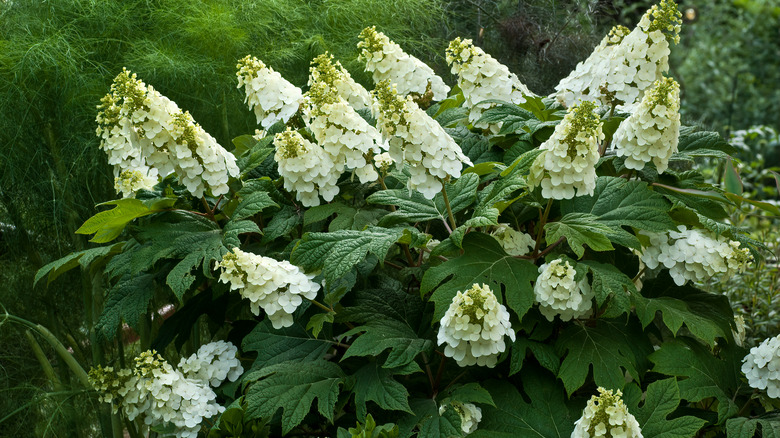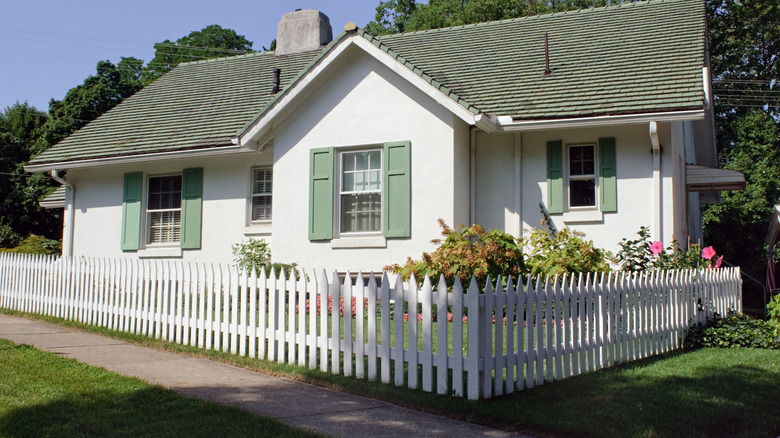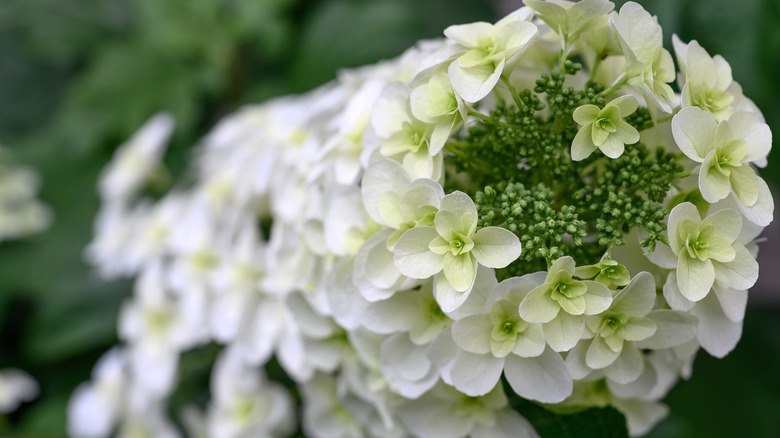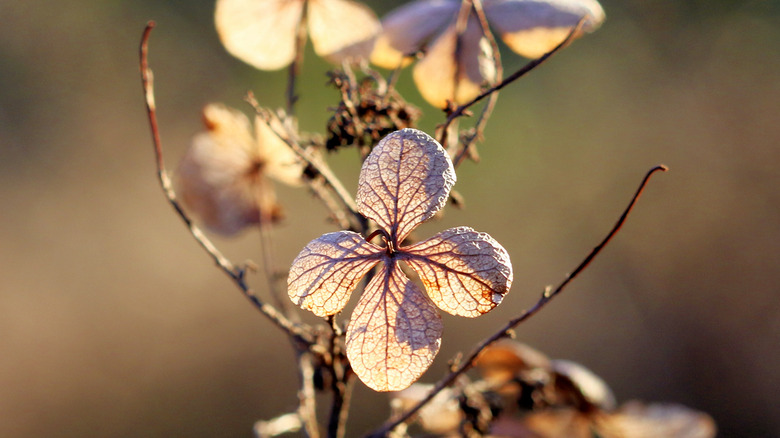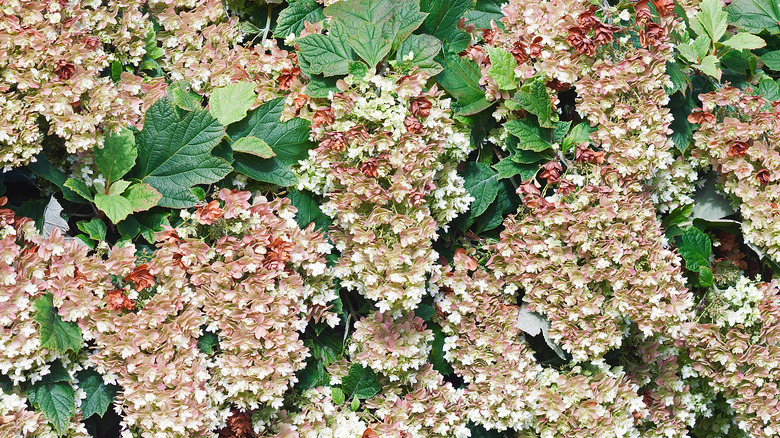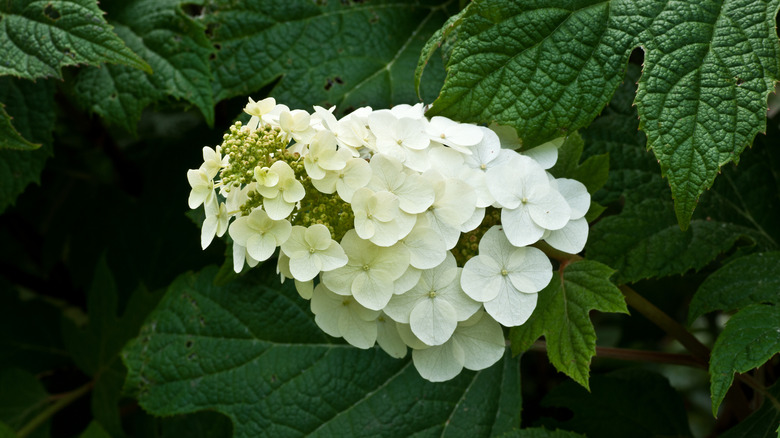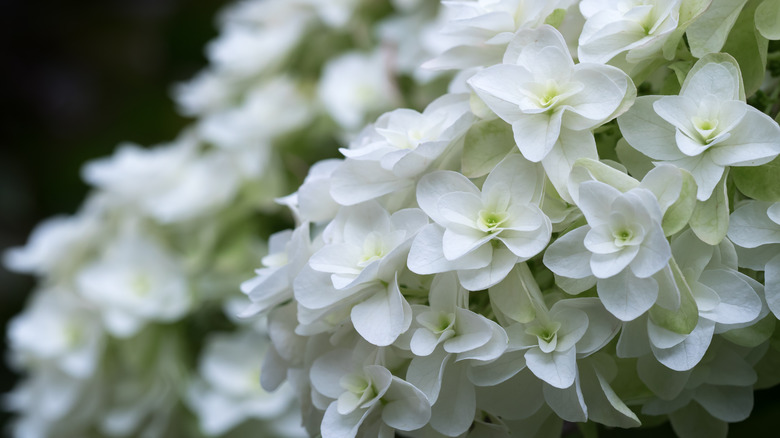Oakleaf Hydrangeas: Everything You Should Know Before Planting
Oakleaf Hydrangeas are a beautiful, full, and flowering plant that make for great additions to any landscaping. Its official name is Hydrangea quercifolia, and it is a deciduous shrub that can grow as high as 8 feet tall. This makes them a great choice for filling in any gaps around your house's foundation or for covering sensitive areas like windows, per the Missouri Botanical Garden.
These stunning shrubs are characterized by their oakleaf-shaped leaves that can range in size anywhere from 4 to 12 inches, and have a particular fuzz when first growing. Once fall rolls around, these leaves tend to turn a red or purple-ish color, and the plant typically blooms in late spring through the summer. Most oakleaf hydrangeas are loved for their distinct, bright-white petals that eventually turn pink, and then once through their life cycles, a faded brown. Oakleaf hydrangeas maintain their blooms all through the summer, making them a solid and reliable statement plant to add to your garden (via North Carolina State University).
How to use oakleaf hydrangeas in garden
Oakleaf hydrangeas are dramatic, beautiful blooming shrubs. They are especially loved for their fullness when fully grown, making them exceptional statement plants. They also work very well as shrubs alongside houses for covering exposed foundation or filling in gaps between other plants. Additionally, The Spruce notes that oakleaf hydrangeas are especially good specimen plants, meaning they are the star of the show of a lawn or garden, planted alone for decorative effect.
If you're trying to incorporate oakleaf hydrangeas with other plants in your garden, Piedmont Master Gardeners suggests planting alongside boxwoods for contrast in densities and fullness, or ferns that grow higher in height like cinnamon or ostrich ferns; you can also opt for plants that aren't as tall, like liriope, for example. As for where to place your oakleaf hydrangeas, you have quite a few options; aside from planting in front of your foundation, you can plant your hydrangeas along a front porch, as bookends in your garden, or in solo spots at the foot of a driveway or surrounding a mailbox, according to SF Gate.
How to grow oakleaf hydrangeas
When sown under the right conditions, oakleaf hydrangeas are fairly easy to grow. Plant Addicts writes that oakleaf hydrangeas can thrive with little attention, making them a pretty low-maintenance plant. Their seeds can typically be purchased in two varieties: single blossoms or double, which is rather self-explanatory; single blossoms result in eventual blooms that are singular-looking, whereas double blossoms appear to have a double layer of petals.
Despite needing less care and attention than other garden plants, oakleaf hydrangeas do still love well-draining soil and a fair amount of light, with a western light exposure being preferred, according to Martha Stewart. Oakleaf hydrangeas also grow best in USDA hardiness zones 5 through 9. For those who aren't familiar, hardiness zones are designed for gardeners to know which plants will grow best in certain regions (via the USDA). It is suggested that you plant oakleaf hydrangeas in late fall or early spring, as this is when the plant is typically dormant and therefore won't be stressed by high temperatures.
This variety of hydrangea can handle light sources anywhere from part shade to full sun, and thrive along the borders of woodlands, making them a good transition shrub from established garden beds to something more natural-looking. Just know that the big, beautiful blooms will only happen given there is enough sunlight, particularly on mature, woody stems.
How to care for oakleaf hydrangeas
According to Gardening Know How, oakleaf hydrangeas are virtually disease and pest free. Once the plant has rooted and is fairly established, they are also pretty drought resistant. Those are words that every gardener loves to hear.
Still, you want to make sure you're caring for oakleaf hydrangea to the best of your ability, which includes regularly watering these shrubs that can survive in drier areas, but whose blooms thrive on consistent water schedules. City Floral suggests giving your hydrangeas around 1 inch of water throughout the week, but increasing that amount if they are getting more sun. During peak summer days and if your hydrangeas are in full sun, 2 inches of water per week is recommended.
A common question for those who have never planted oakleaf hydrangeas before is if they require added fertilizer. Martha Stewart says skipping fertilizer is totally okay; however, if your oakleaf hydrangea is drooping, is not blooming when it should, or is showing other signs of distress, adding a little fertilizer can offer a helpful boost. Cedar mulch makes a great base for your hydrangea as it helps preserve soil moisture and contains and preserves nutrients (via Gardening Chores). Finally, Gardening Know How points out that pruning as the plant grows can certainly go a long way with controlling growth and keeping your oakleaf hydrangea happy and healthy.
Varieties of oakleaf hydrangeas
While there are a number of varieties of hydrangeas with oakleaf being just one within the plant genus, oakleaf hydrangeas themselves offer a variety of similar and different looking plants. According to Piedmont Master Gardeners, there are tall, medium, and compact varieties of oakleaf hydrangeas, with about 15 listed in this particular source. The varieties range from the small "Sikes Dwarf" oakleaf hydrangea, which grows only 2 to 4 feet tall by 3 to 4 feet wide, to the "Alice," which can grow up to 12 feet tall by 12 feet wide.
These varying types of oakleaf hydrangeas also present different kinds of blooms. Every aspect of the plant — from the color or layering of the petals to the shape, size, and position of the blooms — can differ between oakleaf hydrangea varieties. Horticulture Mag lists the Flemygea or "Snow Queen" variety of oakleaf hydrangea as its favorite, with the aforementioned "Sikes Dwarf" and "Alice" also appearing on the (brief) list.
Are oakleaf hydrangeas toxic?
While oakleaf hydrangeas are certainly beautiful and loved for being relatively low-maintenance, there are definitely a few things to be aware of should you choose to plant them in your garden or around your home. One thing to keep in mind about these beautiful flowering plants is that they can be toxic, though the severity is relatively low. Any cause for concern is really if any of the plant is ingested, especially in large quantities, per North Carolina State University. That said, make sure to keep a careful eye on any small children or rambunctious pets playing out in the yard. If you suspect someone you know has ingested oakleaf hydrangeas, be sure to call your local Poison Control Center.
Aside from being ingested, oakleaf hydrangeas don't pose much other threat. They don't have a harmful sap within leaves or petals, thorns along branches, or cause any allergic reactions or rashes (such as poison ivy or poison oak). Luckily, they are almost just as safe as they are beautiful.
Other notable features of oakleaf hydrangea
Pennington notes that the oakleaf hydrangea is a gardener's favorite due to its resilience, low maintenance, beauty, versatility, and accessibility. The plant is native to the American Southeast, and Piedmont Master Gardeners specifies that it is found anywhere from North Carolina to Florida and as far West as Louisiana. It offers full foliage year-round, with particularly stunning blooms in late summer and fall.
What's interesting about oakleaf hydrangeas in comparison to their cousin, the mophead hydrangea, is that soil pH does not affect the color of their blooms. Maintaining a healthy soil pH is always important for any plant, but don't expect the oakleaf to overtly let you know like its counterpart might.
Also interesting is the alleged origin story of the oakleaf hydrangea; according to The House and Home Magazine, William Bartram and his father, John Bartram (notable American naturalists and botanists), are credited with the discovery of the oakleaf hydrangea. Supposedly, in the 1700s, the pair explored the American southeast, including the southern Appalachian Mountains, where they gathered and identified indigenous plants. It is during this period that William came across the oakleaf hydrangea around 1776.
